Kitchen Island Lighting: How To Choose The Right Lights For Your Kitchen Island?
Kitchen islands have become an increasingly popular trend in recent home construction. According to the 2020 U.S. Houzz Kitchen Trends Study [1], which surveyed nearly 2,600 users, 61% of upgraded kitchens now feature islands. A third of homeowners remodeling their kitchens are adding islands, while others are either upgrading existing ones or keeping them unchanged.
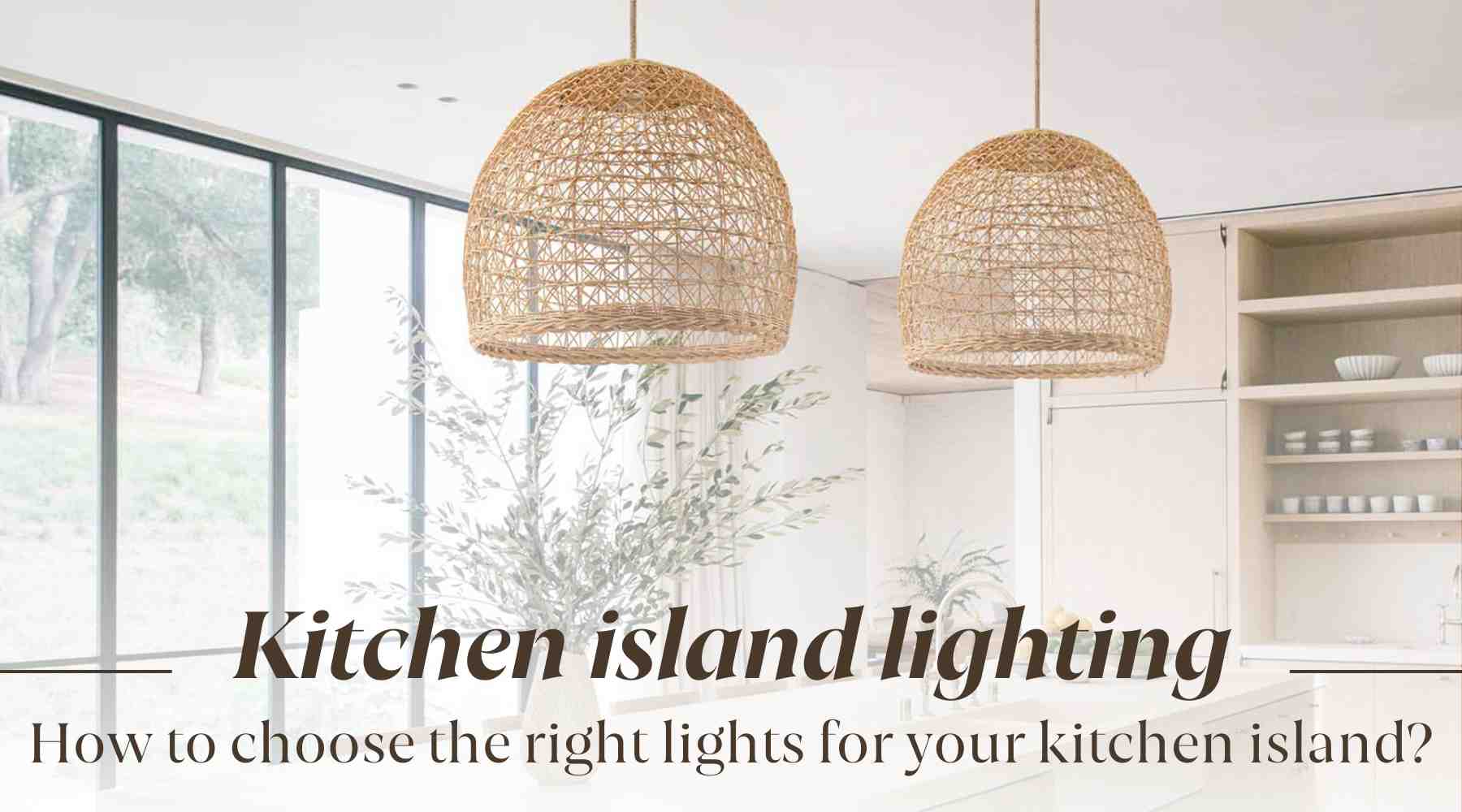
To ensure a kitchen island serves its functional purpose while also creating the perfect ambiance for both guests and homeowners, lighting plays a crucial role. This comprehensive guide delves into key considerations for selecting the ideal kitchen island lighting. Whether you're constructing a new kitchen, renovating an existing one, or simply seeking to enhance your island lighting, this guide offers the insights and inspiration you need.
Key points:
- Selecting the right lighting for a kitchen island can turn the area into central hub for gatherings and contribute to the whole aesthetic.
- Factors to consider when choosing kitchen island lighting is the size and shape of the island, the style of the kitchen, the level of brightness and the overall ambiance you desire.
- Properly install pendant lights in the fastest and easiest way.
- There are plenty of options when it comes to lighting, including pendant lights, chandeliers, recessed lighting and track lights.
- Listing out kitchen styles that are popular for the last couple of years.
- Take aways tips when choosing lighting for the kitchen island.
- A quick guide to choosing kitchen island pendant lighting
- Task lighting
- Ambient lighting
- Accent lighting
- Determining the number of lights to put over your island
- Finding the right height for your pendant lights
- Decorative
- Considering your kitchen’s color palette
- Match or complement
- Kitchen island’s size
- Cost consideration
- Tips for installing kitchen island lighting
- Types of kitchen island lighting
- Kitchen Interior Styles
- Takeaway tips for choosing your kitchen island lighting
- FAQs - Choose the right lights for your kitchen island
- Conclusion
A quick guide to choosing kitchen island pendant lighting
If you find yourself lost in the world of lighting, there's no easy way out simply because the options are vast, and not everything that catches your eye will necessarily fit. That's why we've compiled a list of considerations for you to ponder beforehand:
Task lighting
Task lighting is crucial for focused illumination during food preparation and cooking activities in the kitchen. Since the kitchen island serves as a dual-purpose space for cooking and dining, having sufficient light for these tasks is essential.
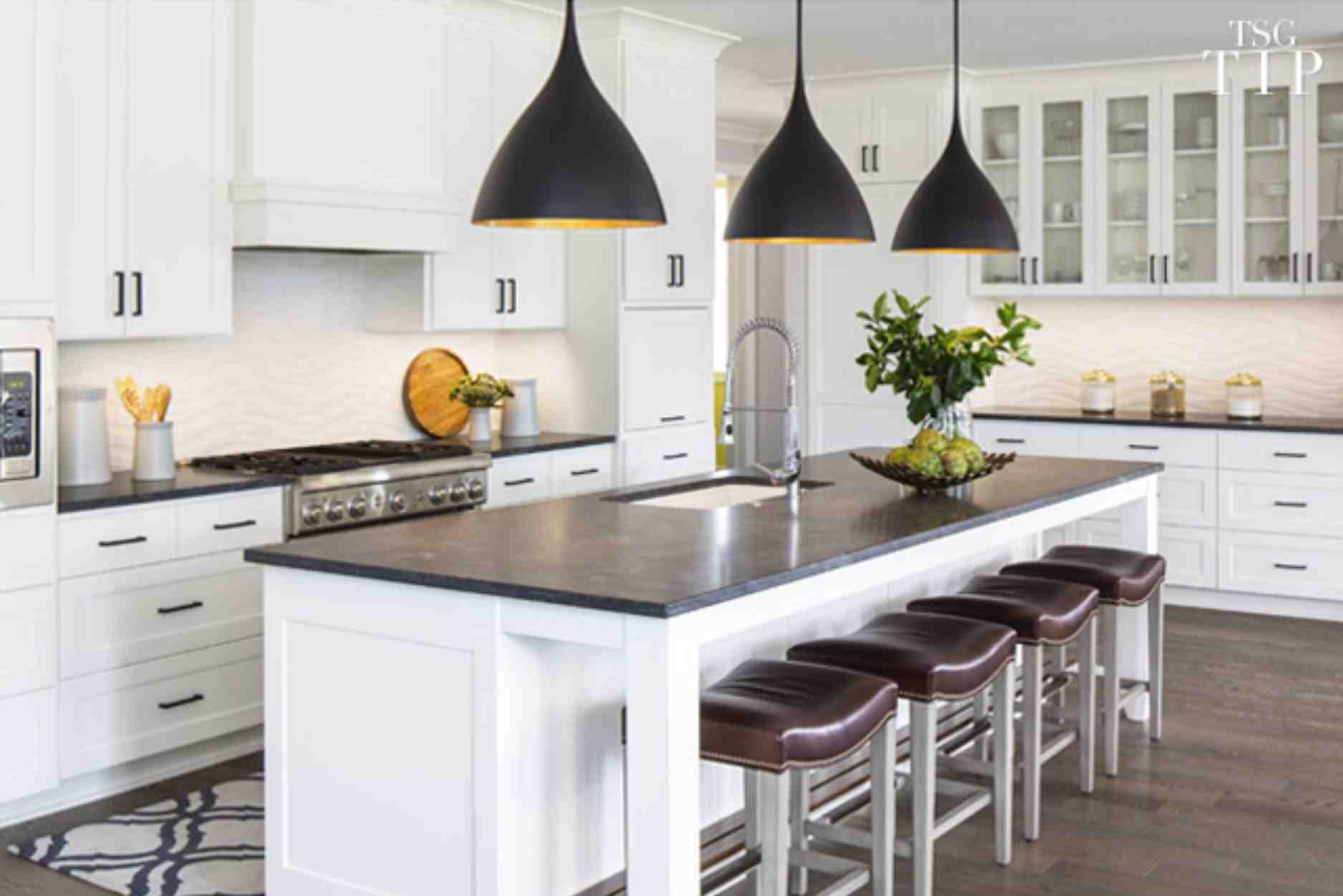
The kitchen island requires task lighting to facilitate cooking activities. Source: The Scout Guide [2]
Therefore, choosing lighting fixtures specifically designed to provide focused illumination for food preparation and cooking tasks is vital to ensure efficiency and safety in the kitchen.
Ambient lighting
Take a moment to envision how your pendant lights will contribute to the overall ambient lighting in your kitchen space. If you're still unsure, here's a helpful tip from Rowabi: consider pendant lights that emit a softer, diffused glow. This choice can help create a warm and inviting atmosphere, perfect for the kitchen, where we gather, bond, and share special moments.
Accent lighting
Since we often desire functionality to go hand in hand with aesthetics, consider this additional tip when choosing lighting: pendant lights can be used to highlight specific areas of the kitchen island.
You can utilize pendant lights as accent lighting while still providing sufficient task lighting. Placing them as centerpieces right above the middle of the countertop can effectively achieve this balance.
Determining the number of lights to put over your island
When selecting lighting fixtures, consider how many will be needed to cover the entire kitchen island adequately. Each pendant light comes in various sizes, and depending on your preferred size, the arrangement of the lights will differ.
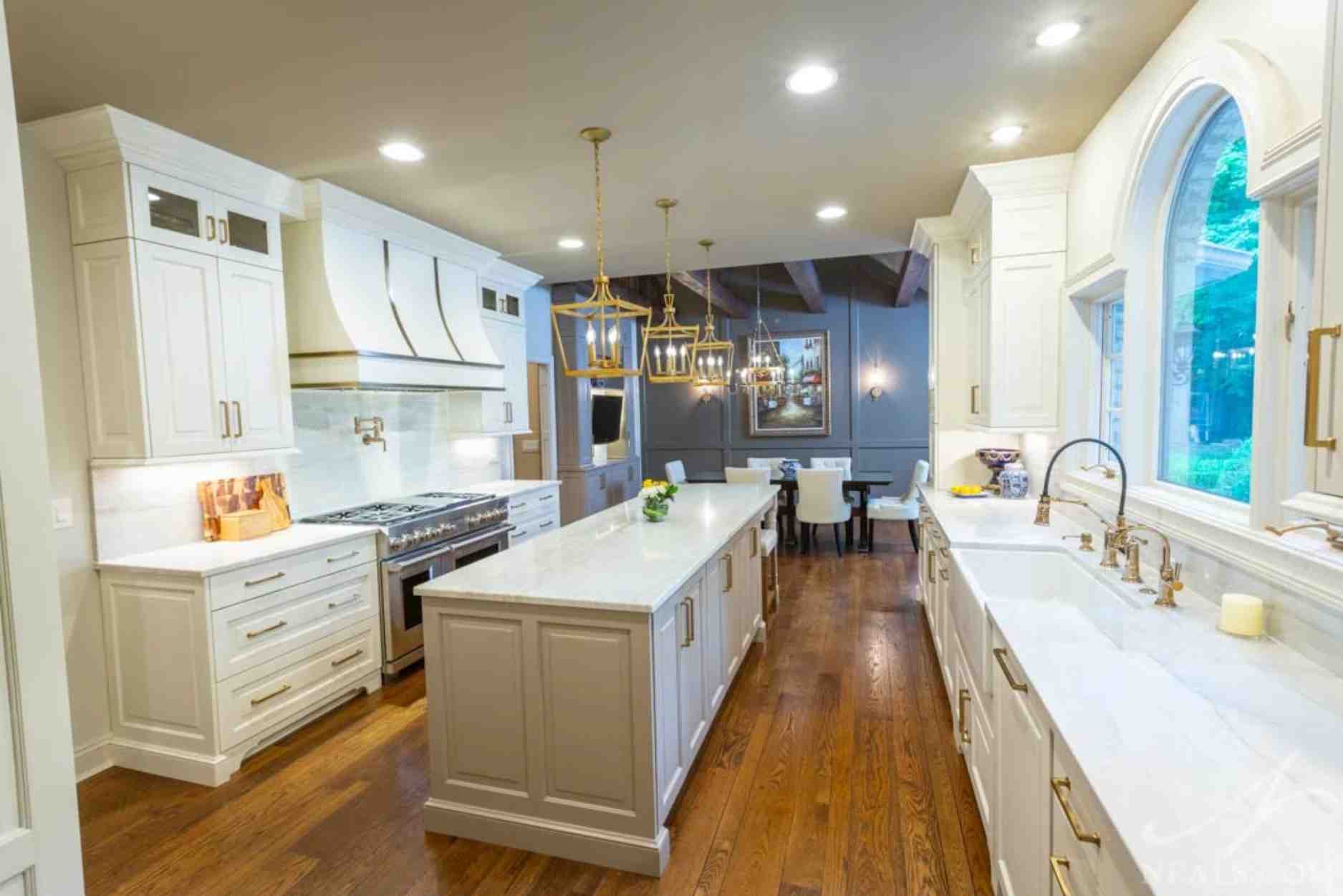
The number of lights is chosen based on the width of the island you're using. Source: Neal’s Home Remodeling and Design Blog [3]
Here's a tip for you: aim for one pendant light for every two feet (approximately 61 centimeters) of island length to achieve uniform illumination. It’s advisable to use an odd number of pendants (3, 5, or 7) for larger islands to create a balanced and visually appealing arrangement.
Finding the right height for your pendant lights
Finding the right height is crucial, especially in areas that directly impact daily activities like the kitchen island. Strategically placing lights can also help keep the room airy and spacious, as improper placement can make it feel cramped.
Typically, we advise maintaining a distance of 30-36 inches (76-91 centimeters) between the top of your island, counter, or kitchen workbench and the bottom of your pendant lights.
Decorative
Choosing the right lighting fixture can elevate the overall design style of your kitchen, aligning with your preferred aesthetic. Each style, whether modern, traditional, rustic, or industrial, features different types of lighting fixtures that complement its unique characteristics. Pay attention to details such as finish, material, and shape to ensure coherence.
Considering your kitchen’s color palette
These days, finding the perfect lighting fixture in terms of color and style has become much easier. Expand your options by creating color palettes and meticulously curated visual boards to help narrow down your choices.
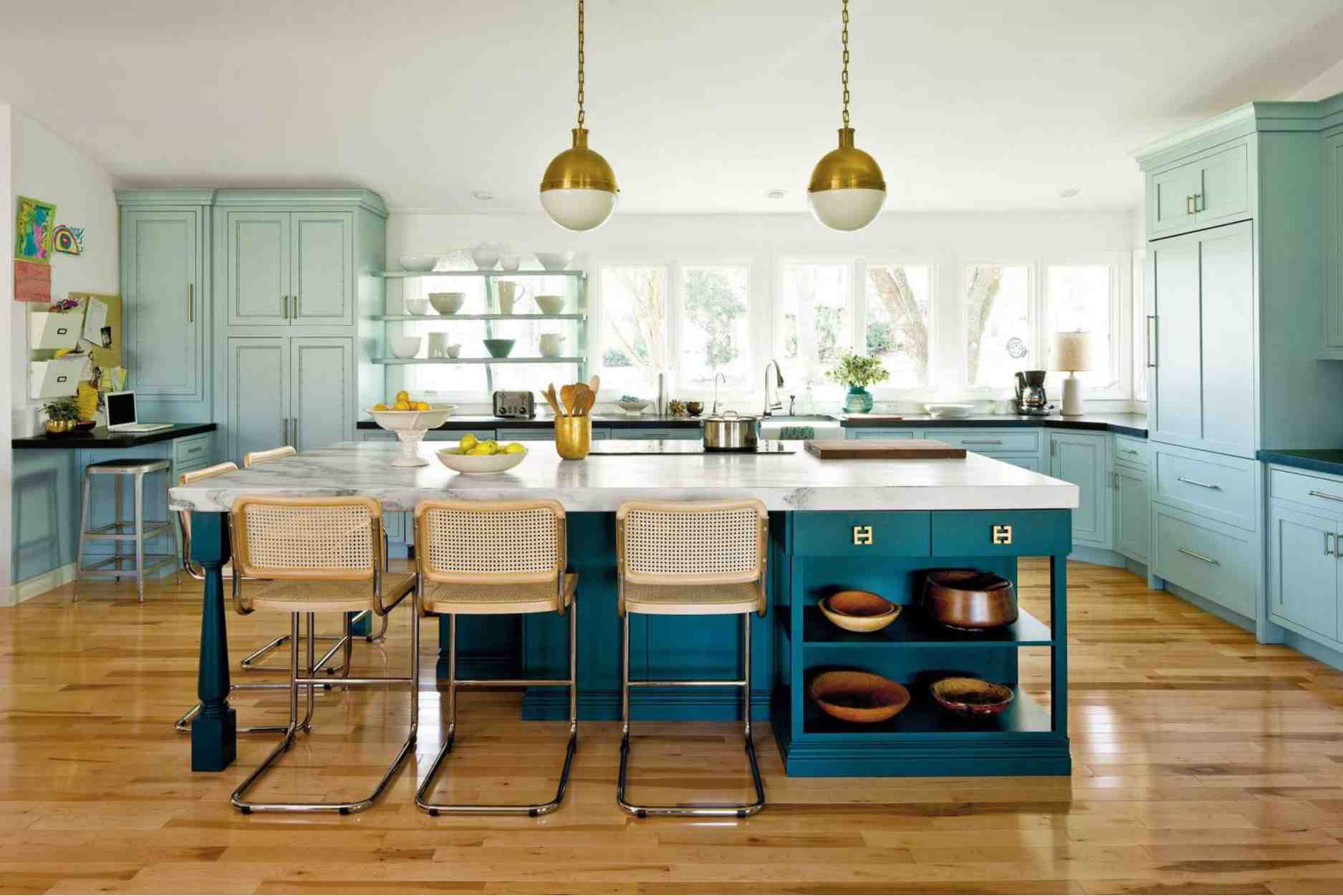
The color palette directly influences the material you choose for your home lighting fixtures. Source: Southern Living [4]
Here are small tips for you when choosing which to buy: neutral tones such as black, white, or stainless steel provide versatility and timeless appeal, while bold colors or distinctive finishes can act as statement pieces, adding visual interest into your kitchen island.
Match or complement
Don't overlook the visual aspect when choosing lights, as they can completely transform your home. Select lights that align with your kitchen color palette and existing furniture.
Typically, this matching comes from elements like color, shape, angles, and materials. There are various combinations of materials that can be used together to create the unique focal points of your home. If your favorite light lacks the desired color, consider painting it, or if you can't find the right light, try DIY-ing one to suit your needs.
Kitchen island’s size
Ensure that the size of your pendant lights corresponds proportionally to the size of your kitchen island to maximize functionality. A useful guideline is to select fixtures that are roughly one-third the width of your island.
Cost consideration
Set a budget for your kitchen island lighting and allocate funds accordingly. There is a wide range of lighting options available, from budget-friendly to high-end, each offering different materials and quality levels.
Remember that while cheaper fixtures may be appealing initially, the results may not match those of more expensive options. Additionally, consider the costs associated with installation and maintenance, as these can also significantly impact your overall expenses.
Tips for installing kitchen island lighting
When installing kitchen island lighting, it's important to consider several factors to ensure a successful and efficient process.
Determine the number of fixtures
Firstly, determine the number of fixtures needed for your island. A general guideline is to use one pendant light for every two feet of island length to achieve even illumination. Installing an odd number of fixtures for larger islands, such as 3, 5, or 7, can create a balanced, appealing arrangement. Be mindful of the size of the fixtures and the overall scale of your kitchen to avoid overwhelming the space.
Choose the right size fixture
Next, choose the right size fixture that is proportional to the size of your kitchen island. Typically, pendant lights should be about one-third the width of the island. Consider the height of your ceiling and the desired hanging height of the fixtures to ensure adequate clearance and comfort. Using a measuring tape, determine your pendant lights’ ideal size and placement before purchasing.
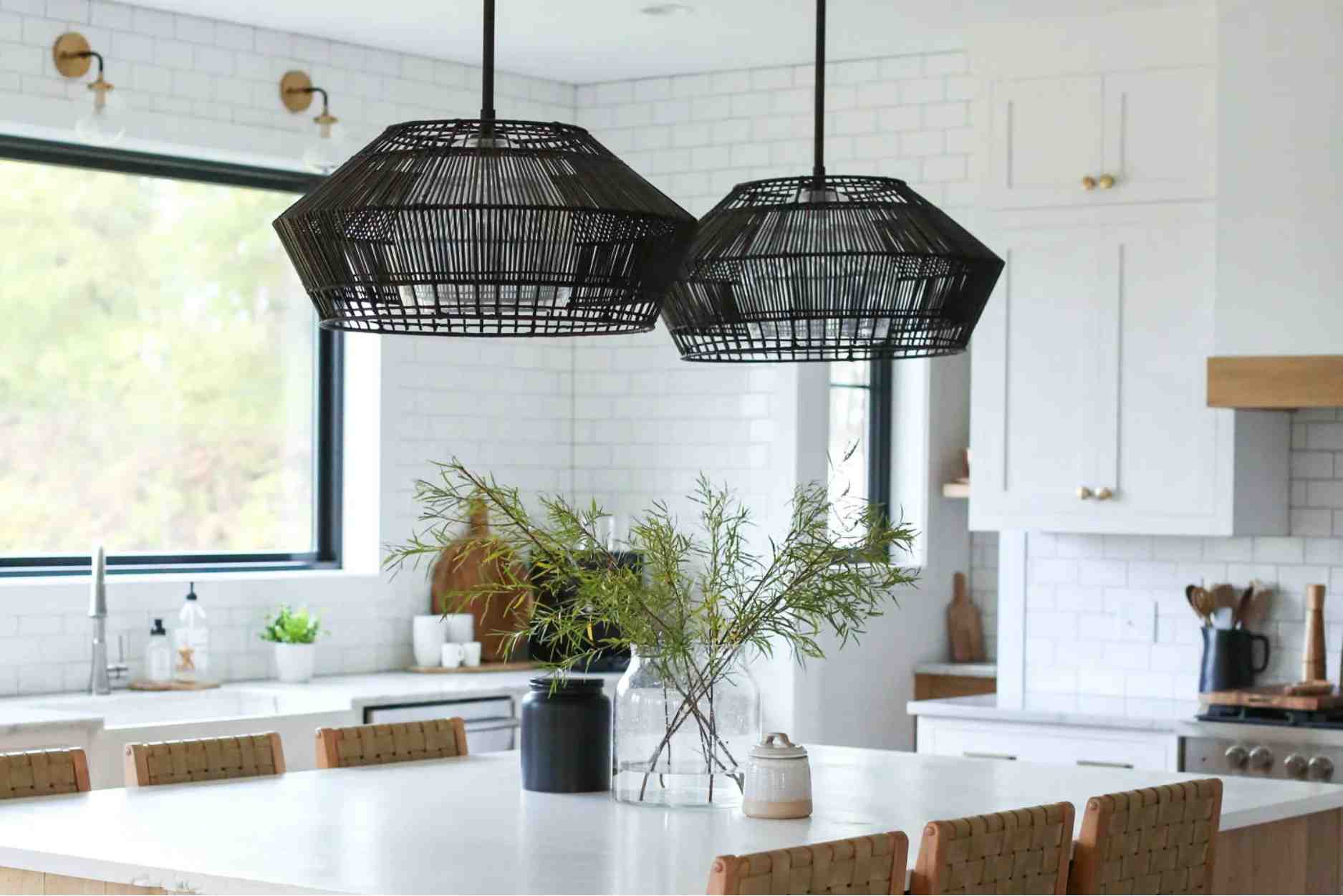
The sizing of pendant lights can either open up or close in a room. Source: 2Modern [5]
Consider wiring and electrical needs
Additionally, consider your wiring and electrical needs. Assess your current electrical setup to determine if any upgrades or additional wiring are necessary to accommodate your new island lighting.
It's advisable to consult with a licensed electrician to ensure that your electrical system can handle the added load and that the wiring is up to code. If your island lacks pre-existing electrical outlets or wiring, consider hiring a professional to install them for safety and productivity.
Types of kitchen island lighting
Today, we have a diverse range of options when it comes to lighting. In this section, we will introduce four popular types: pendant lighting, chandeliers, track lighting, and recessed lighting.
Pendant lighting
Pendant lighting is the smartest and most popular choice when it comes to lighting above the kitchen island. Why is that? Pendant lights, unlike chandeliers, are not ornate and glossy. Instead, they offer a subtle, delicate, and detail-oriented aesthetic.
Just like how people want the kitchen island to be perceived—not as elaborate as the living room but still significantly contributing to the space. Pendant lights strike the perfect balance, serving as both decorative elements and providing focused task lighting for activities such as food preparation and cooking.

The Lumiere Bowl Rattan Pendant Light is popular for placing over kitchen islands. Source: Rowabi
Common materials used for pendant lights for kitchen islands include metal, glass, wood, and rattan. In recent trends, when people mention pendant lights, rattan comes to mind. Rattan is recognized as an excellent material for creating sustainable lighting fixtures that are both fashionable and functional. Its natural and pure beauty brings a sense of comfort, warmth, and coziness to the kitchen, making it a popular choice for pendant lights.
Chandeliers
Chandeliers differ from pendant lights in exuding a sense of luxury, elegance, and sophistication, focusing on intricate materials and elaborate designs.
However, when it comes to kitchen islands, it's best to opt for smaller and linear models to complement the island's length without overpowering the space. These lights serve as statement pieces, allowing surrounding furniture to remain simple and create a focal point in the room.
Track lighting
Track lighting is ideal for minimalist, modern homes, offering simplicity while remaining contemporary. It provides flexibility in directing light precisely where needed, making it perfect for kitchen islands.
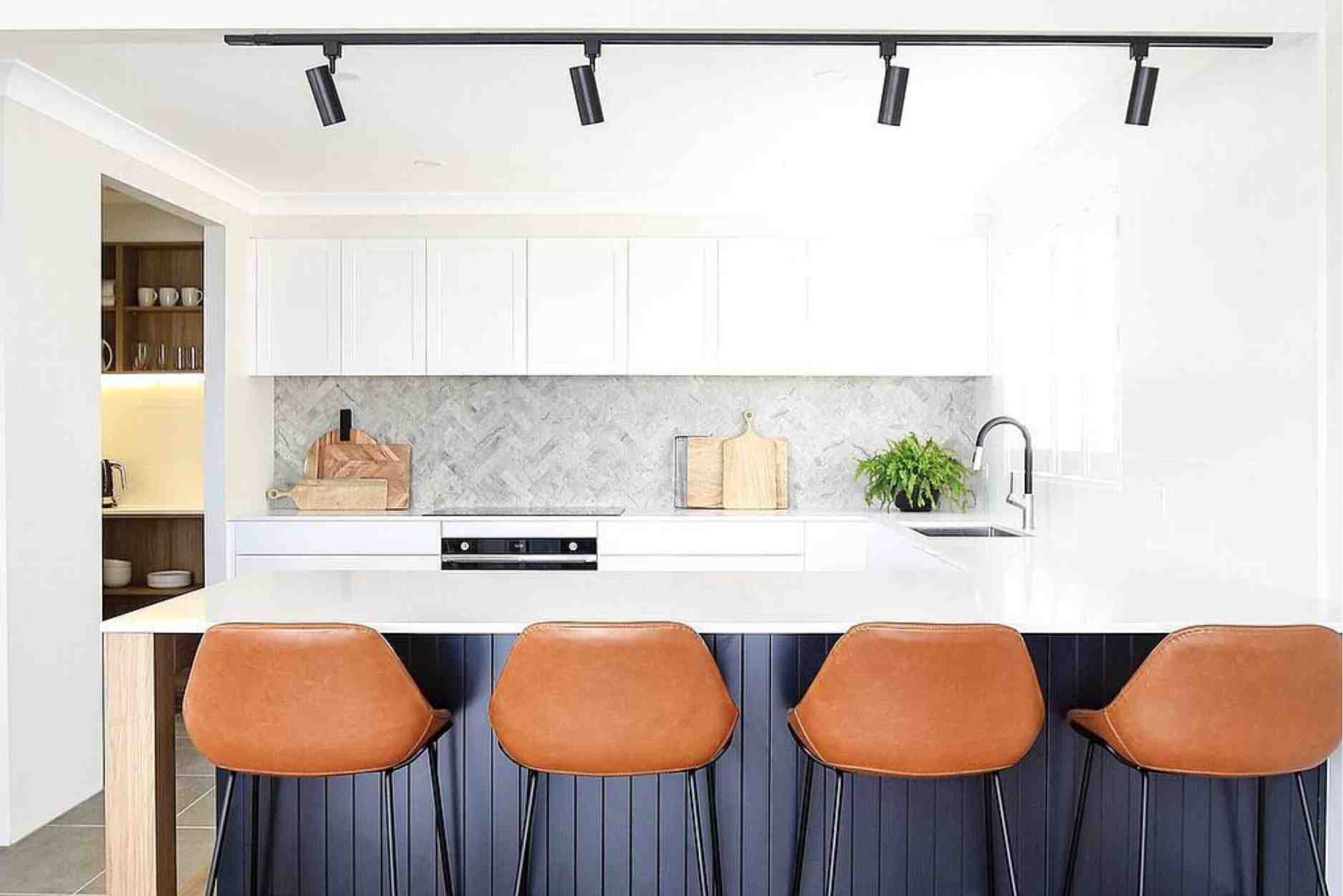
Track lighting directly illuminates specific focal areas. Source: MyDomaine [6]
These lights minimize shadows during activities and focus on crucial areas. Therefore, it's advisable to install track lighting along the length of the island to maximize the illuminated area.
Recessed lighting
Recessed lighting can be strategically positioned above a kitchen island to provide either general ambient lighting or to accentuate specific features. Typically installed directly into the ceiling, these lights offer widespread illumination when the chosen quantity is appropriate.
They can be arranged in a grid pattern to ensure uniformity in lighting. Opting for dimmable recessed lights allows for flexibility in adjusting the brightness level, providing versatility in lighting options. This feature is not commonly found in all types of lighting fixtures.
Kitchen Interior Styles
Choosing a kitchen interior style is crucial as it sets the overall tone and guides decisions for both pendant lights and accompanying furniture. This year's prominent interior styles for kitchens include industrial, mid-century modern, vintage farmhouse, traditional, and contemporary.
Industrial
Industrial kitchens are characterized by raw and rugged materials, reflecting a focus on a dusty, modern, and unique aesthetic reminiscent of factories or workshops. Common materials in this style include brick, concrete, and metal.

You'll often find metal and transparent materials associated with industrial kitchen style. Source: Reddit [7]
When it comes to lighting, the industrial style features utilitarian designs, often incorporating elements such as Edison bulbs and wire cages or metal finishes such as brushed steel, iron, or blackened bronze.
Mid-century modern
Mid-century modern kitchens embody their name through clean lines, organic shapes, and minimalism, reflecting a sense of individuality. This style of modern design emphasizes functionality while maintaining elegance through consistency in color, overall finishes, and the length and style of fixtures.
In mid-century modern kitchens, pendant lights often feature geometric patterns, sleek metal finishes, and designs inspired by retro aesthetics. Additionally, you can opt for pendant lights made from natural materials such as rattan, bamboo, or wood. These materials have a simple and understated nature, highly suitable for combining with mid-century modern kitchen aesthetics.
Vintage farmhouse
Vintage farmhouse kitchens capture the rustic charm of old country homes, evoking a sense of nostalgia, tranquility, and simplicity. These kitchens often feature reclaimed wood accents and soft, soothing pastel colors, creating a cohesive and harmonious color palette.
Pendant lights in this style typically showcase distressed finishes and intricate detailing, adding a subtle yet distinctive focal point to the space. The overall vibe is gentle and inviting, reminiscent of a bygone era while still maintaining elements of comfort and warmth.
Traditional
Traditional kitchens embody simplicity in overall design but showcase meticulous attention to detail and materials. Despite their classic design, they must exude uniqueness and reflect the homeowner’s personality.
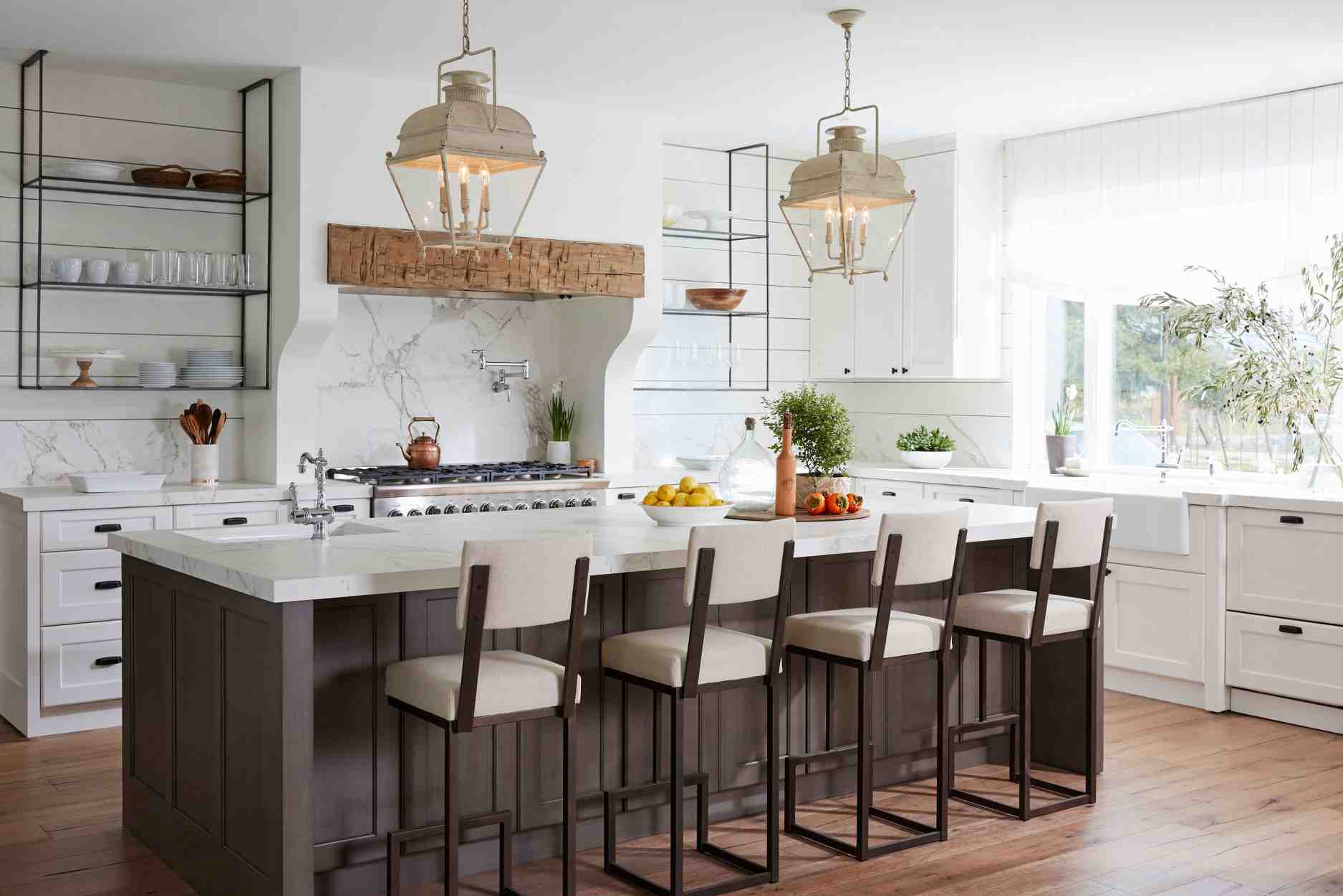
Traditional lighting typically exudes elegance. Source: Better Homes & Gardens [8]
Pendant lights in traditional kitchens often feature intricate details such as crystal accents, scrollwork, and elaborate metalwork, showcasing craftsmanship and adding a touch of sophistication. Additionally, traditional finishes such as oil-rubbed bronze or antique gold complement the timeless elegance of these kitchens.
Contemporary
Contemporary kitchens are characterized by sleek surfaces and minimalist design principles, resulting in a fresh and modern aesthetic. Unlike Midcentury modern, which tends to be minimalistic and features neutral tones, contemporary kitchens incorporate more curvy furniture and decor with bolder colors.
When it comes to pendant lights, contemporary design often prefers small, round fixtures clustered together at varying heights to create unique focal points in the space.
Takeaway tips for choosing your kitchen island lighting
So, in the above sections, we've delved into the details of what you need to know when choosing kitchen island lighting. Here are a few takeaway tips to summarize everything before making a purchase:
- Size: When selecting pendant lights, choose fixtures that are proportional to the size of your kitchen island, typically about one-third the width of the island. It's best to measure the scale of the kitchen and the height of the ceiling carefully before deciding on the appropriate size.
- Function: Clearly define the purposes for which your kitchen island is used to facilitate accurate lighting calculations. Not all lights are equally suitable for every task, so it's essential to prioritize functionality. Since the kitchen island is a high-activity area, prioritize lighting that enhances convenience and utility for activities such as food preparation, cooking, and dining.
- Drop Height: It's commonly advisable to hang pendant lights with a clearance of approximately 30 to 36 inches above the countertop (measured from the countertop surface to the bottom of the light fixture). However, the drop height should be adjusted based on different factors, such as people’s height and the fixture’s size. When using multiple fixtures, ensure they are uniformly aligned for consistency.
- Color finish: When choosing pendant lights, the color palette and finish are crucial in shaping the overall aesthetic. Choose finishes that coordinate with your other kitchen elements. Consider neutral tones like black, white, or stainless steel for a safe and versatile option that can complement any decor. Alternatively, opt for bold colors or unique finishes to create a statement piece and add visual interest to your space.
- Shades: When selecting shades for your kitchen island lighting, clear glass offers a sleek, modern appearance with visible light bulbs that provide bright, unobstructed illumination. Opal glass shades, on the other hand, create a softer, diffused light, fostering a warm atmosphere while reducing glare and ensuring even light distribution. Brass shades is suitable for both modern and traditional kitchen styles and develop a beautiful patina over time, enhancing their timeless appeal.
FAQs - Choose the right lights for your kitchen island
How do I choose a light over an island?
- There are several factors you should consider when choosing a light for a kitchen island, including the size and style of the area, the proportion of the island, and the function it is used for.
What type of lighting is best over a kitchen island?
- Pendant lighting is commonly preferred for kitchen islands since it can provide focused task lighting while adding aesthetic appeal.
What are the rules for island pendants?
- There are no strict rules, but generally, pendant lights should be proportional to the island's size (around 1/3), spaced evenly, and hung at an appropriate height (around 30”-36” from the surface of the table) for optimal functionality and visual appeal.
How many lights should you have over a kitchen island?
- The number of lights depends on the island's size and lighting needs. As a general guideline, one pendant light for every two feet of island length is recommended.
Do island lights have to be centered?
- Island lights don't have to be precisely centered but should be evenly distributed to provide balanced lighting coverage across the island surface.
What is the best height for lights over an island?
- Pendant lights over an island are typically hung 30 to 36 inches above the countertop to ensure clearance and unhindered movement.
Should the island be lighter or darker than the cabinets?
- Both lighter and darker options can work well, depending on the overall color scheme and style.
What is the trend in kitchen lighting?
- Current trends include using mixed materials, such as metal and natural wood, minimalist designs with clean lines, natural materials like rattan, and the incorporation of energy-efficient LED lighting.
How big should a light fixture be over an island?
- The size of the light fixture should be proportionate to the island's dimensions. As a general guideline, a fixture about one-third the width of the island is recommended.
How far apart should two pendants be over an island?
- For evenly spaced lighting, pendant lights should be spaced about 24 to 30 inches apart, depending on the island's size.
Should you have pendants over the island?
- Pendant lights over an island can enhance both the functionality and style of the space, providing focused task lighting while adding visual interest.
How do you center lights over a kitchen island?
- To center lights over a kitchen island, measure the island's width and divide by two to find the center point. Then, position the lights evenly on either side of this point.
How do you determine the number of pendants over an island?
- Because pendant lights are typically spaced 2 feet apart, you should calculate the island's length and divide it by 2 to determine the appropriate number of lights.
What size pendants for a 6-foot island?
- For a 6-foot island, pendant lights that are approximately 12 to 18 inches in diameter are typically suitable, providing adequate coverage and visual proportion.
Conclusion
So, whatsover you opt for the lighting of your beloved kitchen island, remember that the perfect one is within reach. With the knowledge and inspiration provided in this guide, you're well on your way to creating a stunning and functional space that you and your loved ones will enjoy for years to come.
Source:
- [1]: https://www.houzz.com/magazine/whats-popular-for-kitchen-islands-in-remodeled-kitchens-stsetivw-vs~130148122
- [2]: https://thescoutguide.com/keys-to-kitchen-island-lighting/
- [3]: https://info.neals.com/5-considerations-in-kitchen-island-design
- [4]: https://www.southernliving.com/home/colors/kitchen-island-colors
- [5]: https://www.2modern.com/blogs/modern-how-to/what-size-pendant-light-over-island
- [6]: https://www.mydomaine.com/track-lighting-in-kitchen-5199129
- [7]: https://www.reddit.com/r/kitchenporn/comments/10ky7gc/industrialstyle_kitchen_island/?rdt=39625
- [8]: https://www.bhg.com/kitchen-island-lighting-ideas-7499788
Related Posts

What Height to Hang Pendant Lights and Chandeliers
Pendant lights and chandeliers are two popular choices for homeowners when selecting lighting for their homes. Pendant lights are typically small, simple single light fixtures emphasizing small det...

How To Choose The Right Size Lighting Fixture for Any Room
When choosing a lighting fixture, getting the size and scale right is one of the most challenging aspects for people. Without expertise, it's difficult to determine the appropriate size for each ar...


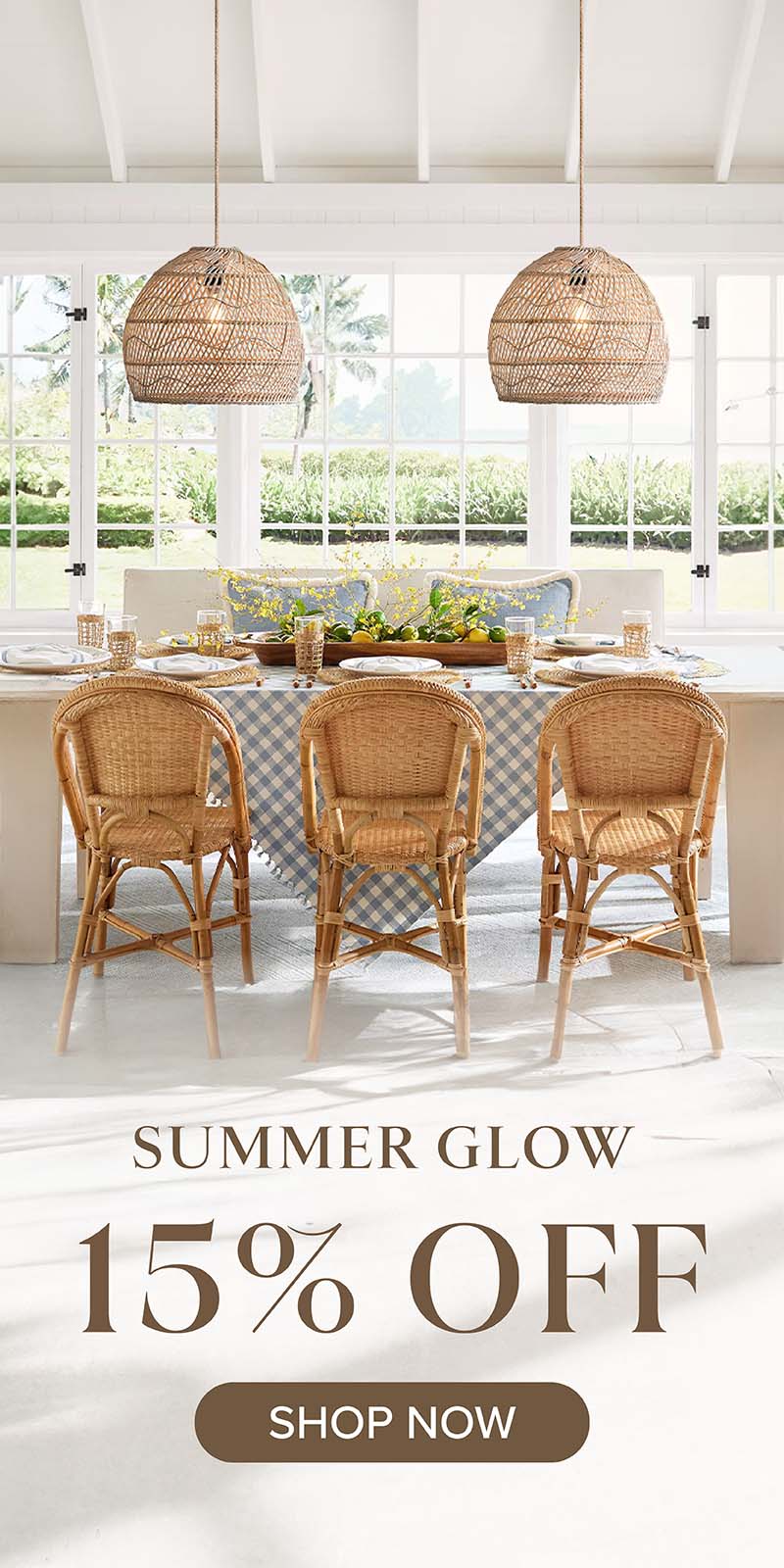
Leave a comment
This site is protected by reCAPTCHA and the Google Privacy Policy and Terms of Service apply.